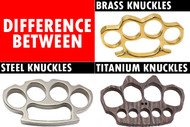Brass Vs Steel Vs Titanium - Which Material Is Best For Knuckle Dusters?
Posted by Swordsswords on Oct 2nd 2023
Real fans and collectors of knuckle dusters know how important it is to choose the right material before buying this self defense tool.
As brass knuckles evolved over the ages, manufacturers started using various alloys and metals do make knucks more effective.
There are 3 most common metals used to make knuckle dusters; brass, stainless steel and titanium. But which material is the best? Brass is shiny and yellow. Steel is strong. Titanium is very light. Each has pros and cons.
In this blog, we'll help you to make the choice of best knuckle dusters by looking at how tough each material is, how it feels and how well it stands up to weathering, as well as other qualities.
Our analysis is based on real data about the properties of brass, steel and titanium.
Let's take a closer look at each option.
Knuckle Duster vs Brass Knuckle

Brass is a popular choice for best knuckle dusters due to its affordability and decorative qualities. Some key things to know about brass knuckles include:
Affordability: Brass is one of the most affordable materials for knuckles. This makes brass a good option for those on a budget.
Decorative Appearance: Brass has an attractive golden color that can be polished to a high shine. Many users choose brass for its decorative aesthetic qualities.
Durability: While more durable than other soft metals, brass is not as durable or impact-resistant as steel or titanium. Brass can dent or deform more easily upon impact.
Weight: Brass knuckles are lighter weight than steel. However, they are heavier than similar-sized titanium knuckles.
Tarnish Resistance: Brass is not highly resistant to tarnishing over time compared to other metals like stainless steel.
Although brass knuckle dusters are affordable and look nice but lack the durability and impact resistance of harder metals like steel and titanium.
Steel Knuckle Dusters

Steel is one of the most popular metals for knuckle dusters due to its excellent strength and durability properties. Steel is an alloy of iron and carbon. Here are some key facts about steel knuckles:
Durability: Steel is an extremely durable metal. It can withstand high impacts without denting or deforming like softer metals, even at high temperatures.
will maintain their form through extensive use.
Strength: The strength of steel allows it to effectively reinforce knuckles during impact. It transmits impact force effectively.
Weight: Steel knuckles have a good strength to weight ratio, being heavier than brass but lighter than similar titanium models. The weight of steel provides heft without being too heavy.
Rust Resistance: Carbon steel knuckles can rust over time when exposed to moisture and elements unless treated with special coatings. Stainless steel varieties resist rust/corrosion.
Affordability: Steel options are more affordable than titanium but may cost slightly more than brass.
In short, steel knuckle dusters provide the best combination of durability, strength, weight, and affordability for most users. The downside is potential rust issues with carbon steel.
Titanium Knuckle Dusters

Titanium is the premium choice when quality and lightweight design are the top priorities. Titanium forms strong alloys with aluminum and vanadium. Here's a quick overview of titanium knuckles:
Lightweight: Titanium is remarkably lightweight while maintaining strength, with an excellent strength to weight ratio. This makes titanium knuckles very comfortable to wear.
Durability: Titanium is one of the strongest and most durable metals. It will maintain shape through heavy impacts, even at high temperatures.
Corrosion Resistance: Titanium is highly resistant to corrosion, so these knuckles will maintain their finish through extensive use and exposure.
Customization: Due to its lightweight properties, titanium lends itself well to intricate custom engraving and designs not possible with heavier metals.
Expense: The premium materials and craftsmanship make titanium knuckles significantly more expensive than brass or steel. Cost effective steel is a more affordable option for most users.
While titanium knuckles provide excellent performance, their high price point means they may not be practical or cost effective for many users.
The Winner
After weighing the pros and cons of each material, steel emerges as the best material for knuckle duster users:
Durability - Steel outperforms softer metals with high impact resistance, able to withstand impacts even at high temperatures to maintain form through heavy use.
Strength - Steel's natural strength effectively reinforces knuckles during impact.
Affordability - As an alloy of iron and carbon, steel offers the best balance of quality and affordability, being more cost effective than titanium.
Weight - Steel knuckles have a good strength to weight ratio, being heavier than titanium but lighter than similar brass models.
Customization - While not as lightweight as titanium, steel still allows for engraving and custom designs.
Only titanium can rival steel's durability advantages due to its high strength titanium alloys. But titanium knuckles represent a major price premium for most users.
Brass is affordable but lacks durability.
Overall, steel delivers the best combination of durability, strength, weight and affordability - making it the ideal material in most cases.
Of course, your needs and budget will also influence the best
choice.
To know more about what type of brass knuckles are available on the market, check out our blog "Exploring the 9 Different Types of Brass Knuckles" and make informed choices!

